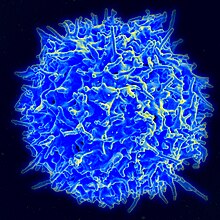Chronic mucocutaneous candidiasis
| Chronic mucocutaneous candidiasis | |
|---|---|
 | |
| This condition is due to T-cells(immune) disorder | |
| Specialty | Infectious diseases, dermatology |
| Types | CANDF1,2,3,4,5,6,7,8 and 9[1] |
| Diagnostic method | Thyroid function test, Liver function test[2][3] |
| Treatment | Systemic antifungal therapy[3] |
Chronic mucocutaneous candidiasis is an immune disorder of T cells,[3] it is characterized by chronic infections with Candida that are limited to mucosal surfaces, skin, and nails.[4]: 310 It can also be associated with other types of infections, such as human papilloma virus. An association with chromosome 2 has been identified.[medical citation needed]
Symptoms and signs
The symptoms of this condition are hyperkeratosis, skin ulcer, dyspareunia, endocardium abnormality, vision problems, hepatitis, seizures, hematuria and meningitis[5]
Cause
In terms of the cause of chronic mucocutaneous candidiasis one finds it can be inherited either autosomal dominant or autosomal recessive[1] There are 9 types of this condition with the first CANDF1 being located at 2p22.3-p21(cytogenetically)[6]
Mechanism
The mechanism of the human immune system has it normally fighting in an infection (like Candida). Initially Th17 cells are made by the immune system, which in turn produces interleukin-17 (IL-17). Inflammation is induced and white blood cells confront infection.[7]
Chronic mucocutaneous candidiasis mutations affect IL-17 by inhibiting its pathway. This in turn affects the human immune systems ability to fight infection, in total there are 9 possible types of this condition.[7][8]
Diagnosis
Chronic mucocutaneous candidiasis can be diagnosed in an affected individual via the following methods/tests:[2][3]
- Thyroid function test
- Liver function test
- Cellular immunity test
- Skin biopsy
- Genetic testing

Types

| Type | OMIMα | Gene | Locus |
|---|---|---|---|
| CANDF1 | Template:OMIM2 | - | 2p |
| CANDF2 | Template:OMIM2 | CARD9 | 9q34.3 |
| CANDF3 | Template:OMIM2 | - | 11 |
| CANDF4 | Template:OMIM2 | CLEC7A | 12p13.2-p12.3 |
| CANDF5 | Template:OMIM2 | IL17RA | 22q11 |
| CANDF6 | Template:OMIM2 | IL17F | 6p12 |
| CANDF7 | Template:OMIM2 | STAT1 | 2q32 |
| CANDF8 | Template:OMIM2 | TRAF3IP2 | 6q21 |
| CANDF9 | Template:OMIM2 | IL17RC | 3q25 |
Treatment

Management for an individual with chronic mucocutaneous candidiasis consists of the following(relapse occurs once treatment is ceased, in many cases):[3][9]
- Systemic antifungal therapy(e.g. Fluconazole)
- Transfer factor
- Combination therapy
- Screening(annually)
See also
Notes
^ Indicates 9 references to specific, numbered pages in the Online Mendelian Inheritance in Man database.
References
- ^ a b RESERVED, INSERM US14 -- ALL RIGHTS. "Orphanet: Chronic mucocutaneous candidiasis". www.orpha.net. Retrieved 2017-06-09.
{{cite web}}: CS1 maint: numeric names: authors list (link) - ^ a b "Familial chronic mucocutaneous candidiasis - Conditions - GTR - NCBI". www.ncbi.nlm.nih.gov. Retrieved 2017-06-09.
- ^ a b c d e "Chronic Mucocutaneous Candidiasis: Background, Pathophysiology, Epidemiology". Medscape. 3 May 2017. Retrieved 8 June 2017.
- ^ James, William D.; Berger, Timothy G. (2006). Andrews' Diseases of the Skin: clinical Dermatology. Saunders Elsevier. ISBN 0-7216-2921-0.
- ^ "Candidiasis familial chronic mucocutaneous, autosomal recessive | Genetic and Rare Diseases Information Center (GARD) – an NCATS Program". rarediseases.info.nih.gov. Retrieved 2017-06-09.
- ^ "OMIM Entry - % 114580 - CANDIDIASIS, FAMILIAL, 1; CANDF1". omim.org. Retrieved 9 June 2017.
- ^ a b Reference, Genetics Home. "familial candidiasis". Genetics Home Reference. Retrieved 2017-06-09.
- ^ Smeekens, Sanne P; van de Veerdonk, Frank L; Kullberg, Bart Jan; Netea, Mihai G (2013). "Genetic susceptibility to Candida infections". EMBO Molecular Medicine. 5 (6): 805–813. doi:10.1002/emmm.201201678. ISSN 1757-4676. PMC 3779444. PMID 23629947.
- ^ Teng, Joyce; Marqueling, Ann L.; Benjamin, Latanya (2016-12-15). Therapy in Pediatric Dermatology: Management of Pediatric Skin Disease. Springer. p. 265. ISBN 9783319436302.
Further reading
- Kauffman, Carol A.; Pappas, Peter G.; Sobel, Jack D.; Dismukes, William E. (2011). Essentials of Clinical Mycology. Springer Science & Business Media. ISBN 9781441966407. Retrieved 9 June 2017.
- Ostler, H. Bruce (2004). Diseases of the Eye and Skin: A Color Atlas. Lippincott Williams & Wilkins. ISBN 9780781749992. Retrieved 9 June 2017.
